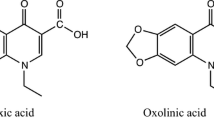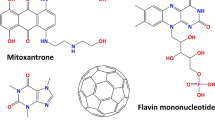Abstract
Desloratadine (DES) is an antihistamine used in the treatment of allergies and chronic urticaria. 1H NMR spectroscopic study of varying ratios of DES and β-Cyclodextrin (β-CD) in D2O suggests the formation of a 1:1 inclusion complex formed by the penetration of Cl-substituted aromatic ring into the β-CD cavity. The stoichiometry and binding constant of the complex were determined by Scott’s method.
Similar content being viewed by others
Avoid common mistakes on your manuscript.
Introduction
Desloratadine (DES), 8-chloro-11-(piperidin-4-ylidene)-6,11-dihydro-5H-benzo[4,5]cyclohepta[2,1-b]pyridine, a new nonsedating H1-antihistamine, is efficacious and safe in the treatment of perennial allergic rhinitis [1] and chronic idiopathic urticaria [2]. It inhibits important cytokin and cellular activity, suggesting an antiallergic and anti-inflammatory profile [3]. DES is a chiral, light sensitive drug whose solubility in water is 0.01 mg/mL.
We are interested in the study of complexation of pharmaceutical compounds with β-cyclodextrin (β-CD) because inclusion of the guest or part of it into the CD cavity leads to altered physicochemical properties of the guest. The host-guest complexes of pharmaceutical compounds with CDs have, therefore, been extensively studied and utilized to improve their solubility [4], dissolution rate [5] and bioavailability of poorly water-soluble drugs [6]. Other applications of CD complexes with pharmaceuticals [7] include elimination of undesirable drug properties, such as irritation and unpleasant odor or taste and improved stability of light and oxygen sensitive drugs.
CDs are doughnut-shaped cyclic oligosaccharides composed of six (α), seven (β), and eight (γ) glucopyranose units linked by α-(1,4) linkages. The exterior of the CDs is highly hydrophilic due to the presence of numerous hydroxyl groups while the interior of the CDs cavity is hydrophobic and, thus, interacts with a variety of hydrophobic compounds to form inclusion complexes [8, 9]. The size and shape of the torus shaped hydrophobic cavity in combination with the size, polarity and polarizability of the guest are major determinants for the formation of inclusion complexes.
Various techniques are used to study the CD inclusion complexes but NMR spectroscopy has been found to be an important tool in this type of studies [10]. 1H NMR spectra of mixture of CD and guest molecules are recorded and chemical shift changes (Δδ) for both host as well as guest protons are studied. Inclusion of a molecule inside the CD cavity is characterized by the shift variation of the CD protons located inside the cavity (H-3′ and H-5′), while other CD protons (H-2′, H-4′ and H-6′) are less affected. The highfield shift changes in the CD cavity protons are attributed to the anisotropic ring current effect of the aromatic guest. Beside the determination of stoichiometry and binding constant of the complex, inferences like mode of penetration of the guest, stability of the complexes and depth of penetration may be drawn from simple 1H NMR complexation induced shift data.
ROESY spectroscopy has been found very useful for the investigation of the interactions between CDs and guest molecule [10, 11] since cross peaks are observed in ROESY spectrum between the protons that are closer than 0.4 nm in space. The relative intensities of cross peaks depend on the spaces between the corresponding protons. NOE cross correlation peaks between the guest and β-CD cavity protons (H-3′ and H-5′) are observed when the guest molecule is included into the β-CD cavity. The data proves very helpful in determining the mode and depth of penetration of the guest, and thus establishing the structure of the complex.
We are interested in the study of complexation of pharmaceutical compounds with CDs and report herein our results on the detailed 1H NMR spectroscopic study of the complexation between desloratadine (DES) and β-cyclodextrin (β-CD) in aqueous solution.

Results and discussion
All the 1H NMR spectra were acquired on a JEOL α-500 MHz instruments at room temperature in D2O. The chemical shift values are reported in δ (ppm) relative to the HDO peak at 4.800 ppm. 1H NMR spectra for seven samples of mixtures of DES and β-CD with β-CD/DES molar ratios ranging from 0.15 M–1.70 M were recorded. The concentration of the DES was kept constant at 1.03 × 10−2 M while that of β-CD was varied. All the recorded spectra contained one set of resonances suggesting a fast reversible exchange between free and the complexed drug, on the NMR time scale.
A detailed inspection of the β-CD proton signals in the 1H NMR spectra of mixture of DES and β-CD displayed upfield shift changes in the H-3′ and H-5′ proton resonances of β-CD compared to pure β-CD. The upfield shift of β-CD cavity proton signals can be explained in terms of ring current effect of aromatic ring penetrating the β-CD cavity, and therefore, confirming the formation of DES/β-CD inclusion complex in analogy to previous studies [10, 12]. Other β-CD protons also displayed shift changes but these were not significant. Expansions of part of the spectra showing signals for β-CD protons, in the presence as well as absence of DES, are shown in Fig. 1.
To establish which of the two rings was involved in the complexation, an unambiguous resonance assignment of guest protons (DES) in the free as well as complexed state was required which was made with the help of 2D COSY spectral data (Fig. 2). As expected, the signals for pyridine ring protons appeared downfield compared to chlorophenyl ring. The signal in the lowest field appearing at 8.5334 was assigned to H-5 and it showed interaction with H-6 (7.8009) signal in the COSY spectrum. The doublet at 8.2704 was assigned to H-7 as it displayed cross peak with H-6. The signal at 7.3250 was easily attributed to H-9 because it showed interaction with two other signals (H-8 and H-10). The signal at 7.1821 was assigned to H-8 because it exhibited coupling with H-9.
In the presence of β-CD, all the aromatic signals of DES exhibited induced shift changes and splitting. The chemical shift change (Δδ) data for the aromatic protons of DES in presence of β-CD is given in Table 1, while Fig. 3 shows aromatic region of spectra of DES, pure and in the presence of varying amount of β-CD. It was established with the help of ROESY data that only chlorophenyl ring was involved in complexation.
The stoichiometry of DES/β-CD complex was determined by using Scott’s modification [13] of Benesi-Hildebrand equation. In Scott’s equation,
[CD]t is the molar concentration of the CD, Δδobs is the observed chemical shift difference for a given [CD]t concentration, Δδc is the chemical shift difference between a pure sample of complex and the free component at the saturation. The plot of chemical shift changes (Δδ) for the DES protons against [β-CD] in the form of [β-CD]/Δδ versus [β-CD] gave excellent linear fit confirming 1:1 stoichiometry for the DES/β-CD complex (Fig. 4).
The slop of the plot is thus equal to 1/Δδc and the intercept with the vertical axis to 1/K aΔδc allowing the estimation of binding constant (K a) to be 124 M−1
ROESY spectrum of a DES/β-CD mixture under spin lock conditions exhibited cross peaks between chlorophenyl ring and β-CD cavity protons, confirming that only one aromatic ring was involved in the complexation and taking into account the stoichiometry, it becomes obvious that only one 1:1 inclusion complex was formed. Expansion of the part of the ROESY spectrum of DES/β-CD mixture showing aromatic region is given in Fig. 5.
There are two probable structures that can be considered (Fig. 6) which involve the entry of the guest ring from wider rim side. The deep penetration of chlorophenyl from narrower rim side can be ruled out on steric grounds. Mode II was ruled out because it can not explain the interaction of H-8 with β-CD cavity protons, especially H-5′. The mode I was therefore assigned to the complex formed between DES and β-CD under the experimental conditions studied.
Conclusion
1H NMR spectroscopic studies of desloratadine (DES) in the presence of β-CD in D2O at room temperature confirmed the formation of a 1:1 DES/β-CD inclusion complex in which chlorophenyl ring acts as the guest. The binding constant (K a ) for the DES/β-CD complex was determined to be 124 M−1
References
Simons, F.E., Prenner, B.M., Finn, Jr. A., Desloratadine study group: Efficacy and safety of desloratadine in the treatment of perennial allergic rhinitis. J. Clin. Immunol. 111, 617–622 (2003)
Wang, Y.H., Tache, Y., Harris, A.G., Kreutner, W., Daly, A.F., Wei, J.Y.: Desloratadine prevents compound 48/80-induced mast cell degranulation: Visualization using a vital fluorescent dye technique. Allergy 60, 117–124 (2005)
Henz, B.M.: The pharmacologic profile of desloratadine: A review. Allergy, 56, 7–13 (2001)
Esclusa-Diaz, M.T., Gayo-Otero, M., Perez-Marcos, M.B., Villa-Jato, J.L.: Preparation and evolution of ketoconazole-β-cyclodextrin multicomponent complexes. Int. J. Pharm. 142, 183–187 (1996)
Obaidat, A.A., Matalqah, S.M., Najib, N.M.: Improvement and characterization of the in vitro dissolution behavior of sulindac by complexation with β-cyclodextrin. Acta Pharm. 52, 9–18 (2002)
Torres-Labandeira, J.J., Blanco-Mendez, J., Villa-Jato, J.L.: Biopharmaceutical stability of the glibornuride/β-cyclodextrin inclusion complex after one year of storage. STP Pharm. Sci. 4, 235–239 (1994)
Szejtli, J.: Medicinal applications of cyclodextrins. Med. Res. Rev. 14, 353–386 (1994)
Bender, M.L., Komiyama M.: Cyclodextrin Chemistry, pp. 1. Springer Verlag, New York (1978)
Li, S., Purdy, W.C.: Cyclodextrin and their applications in analytical chemistry. Chem. Rev. 92, 1457 (1992)
Schneider, H.J., Hacket, F., Rudiger, V., Ikeda, H.: NMR studies of cyclodextrins and cyclodextrin complexes. Chem. Rev. 98, 1755–1785 (1998) (and references cited therein)
Neuhaus, D., Williamson M.: The Nuclear Overhauser Effect in Structural and Conformational Analysis, VCH Publishers, New York (1989)
Estrada, E., Perdomo-Lo′pez, I., Torres-Labandeira, J.J.: Molecular modeling (MM2 and PM3) and experimental (NMR and thermal analysis) studies on the inclusion complex of salbutamol and β-cyclodextrin. J. Org. Chem. 65, 8510–8517 (2000)
Scott, R.L.: Some comments on the Benesi-Hildebrand equation. Recl. Trav. Chim Pays-Bas 75, 787–789 (1956)
Acknowledgement
We are grateful to the Prof. James M. Coxon, Dr. Axel T. Neffe and his team, University of Canterbury, Christchurch, New Zealand, for help in obtaining some of the NMR data. We are also grateful to Morpen Laboratories Ltd., India, for providing pure sample of desloratadine.
Author information
Authors and Affiliations
Corresponding author
Rights and permissions
About this article
Cite this article
Ali, S.M., Upadhyay, S.K. & Maheshwari, A. NMR spectroscopic study of the inclusion complex of desloratadine with β-cyclodextrin in solution. J Incl Phenom Macrocycl Chem 59, 351–355 (2007). https://doi.org/10.1007/s10847-007-9335-y
Received:
Accepted:
Published:
Issue Date:
DOI: https://doi.org/10.1007/s10847-007-9335-y










